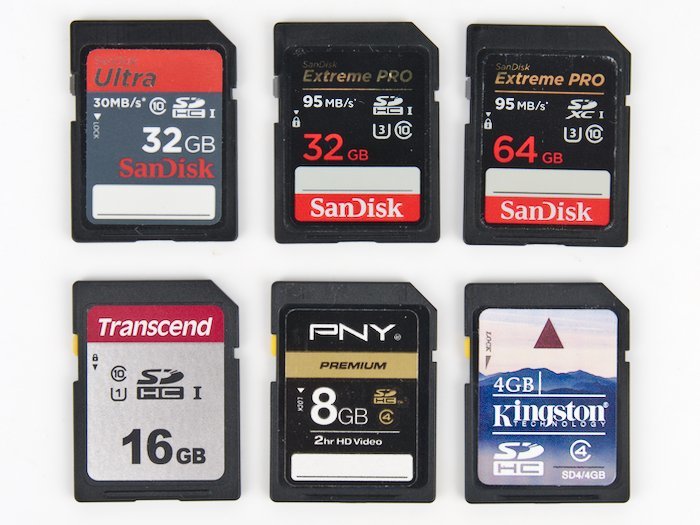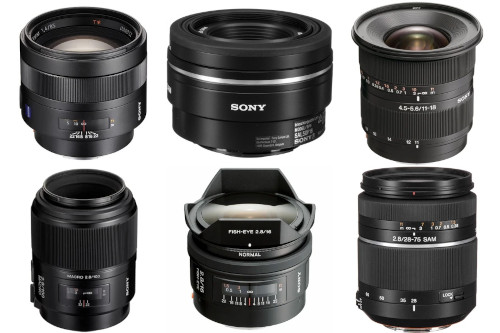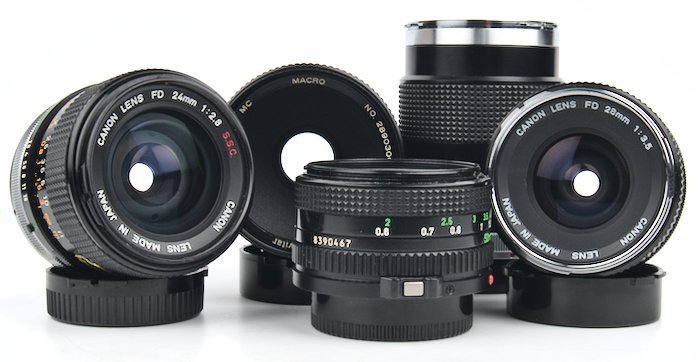
The 5 Best Canon A-1 Camera Lenses
- Nathaniel Stephan
- Canon a 1
- March 17, 2020
Table of Contents
The A-1 is an excellent analog camera.
This article will discuss the top 5 lenses to use on the A-1 camera.
Affiliate Advertising Disclosure
Outside the Shot is a participant in the Amazon Services LLC Associates Program, an affiliate advertising program designed to provide a means for sites to earn advertising fees by advertising and linking to Amazon.com.
As an eBay Partner, I may be compensated if you make a purchase. I also participate in affiliate advertising programs with KEH and Adorama. More can be found on the Affiliate Disclosure page.
Additional information is further down, however if you’re short on time, here is the list:
- Kit Lens - Canon FD 50mm f/1.8 (eBay)
- Wide Angle Lens - Canon FD 28mm f/3.5 (Amazon)
- Portrait Lens - Canon FD 100mm f/2.8 (Amazon)
- Zoom Lens - Vivitar Series 1 70-210mm f/3.5 (eBay)
- Macro Lens - Vivitar 90mm f/2.8 (eBay)
Kit Lens and Standard Primes
Canon FD 50mm f/1.8
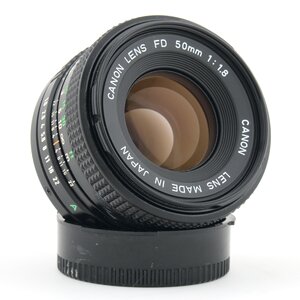
If you don’t already have it, your first lens should be the original “kit lens” for the A-1, the Canon FD 50mm f/1.8. The 50mm f1.8 is budget-friendly, widely available used, and has good image quality.
- The “classic” setup as it can be considered the original kit lens.
- Unbeatable value.
- Light and compact.
- Widely available and easy to find in good condition.
- Uses 55mm filter threads.
Check a variety of places to find the best condition and price.
See current price and more information on:
A 50mm camera lens is a fantastic choice for many different types of photography. The types of photography include portraits, architecture, street, everyday use, landscapes, and travel. This is the most widespread focal length that is used with the A-1.
The lens is small, well balanced, and light. Depending on the version of the lens, it will weigh between 170-305g. The new FD version, which was the last to be developed, is the lightest.
Additionally, Canon designed 2 versions with larger apertures for the Canon FD lens mount.
Canon FD 50mm f/1.4
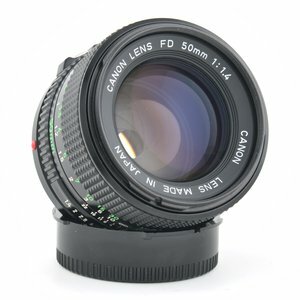
The Canon FD 50mm f/1.4 is 2/3 of a stop faster, but that comes at the cost of additional weight. It is slightly more expensive than the f1.8.
- Excellent image quality.
- Optical multi-coatings.
- Fairly easy to find in good condition.
- Larger and heavier than the f/1.8.
The 50mm f/1.4 comes in 4 different versions. The “new FD” copy is the lightest and newest out of the choices.
See current price and more information on:
This lens is large, heavy, and hard to focus lens. Shot wide open, images will be soft. Stopped down, you aren’t going to notice a sizeable difference between it and the f/1.8 or f/1.4.
The two versions of the lens are pricey. The cost of the lens is as a result of rarity and collectibility, not optical performance.
Alternative Standard Lenses
If the 50mm focal length isn’t what you like, here are some other possible choices. You should expect to spend additional money than you normally would for a 50mm lens of comparable speed.
- Canon FD 35mm f/2 SSC
- Canon FD 35mm f/2.8
- Canon FD 35mm f/3.5
- Canon FD 55mm f/1.2
Wide Angle Lens
Canon FD 28mm f/3.5
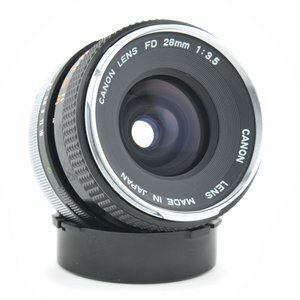
A 28mm focal length lens is often used to shoot street photography. However, lenses that are wider than 28mm are the most popular for architectural and landscape photography.
- Great combination with a 50mm lens.
- Optical multi-coatings.
- Inexpensive and widely available.
- Small and light.
See current price and more information on:
My recommended pick is the Canon FD 28mm f/2.8 thanks to the cheaper price, wide availability, and top notch optics.
Alternative Wide Angle Lenses
In terms of cost, the correlation is easy to understand. The larger the field of view, the less affordable the lens will be. Lenses with larger apertures also sell for significantly more.
Weight will differ based upon on the qualities of the lens. You can find lenses from 170g to 500g. Faster apertures will also mean that those lenses will be bulky and will make the camera more challenging to handle.
- Canon FD 7.5mm f/5.6 Fisheye
- Canon FD 14mm f/2.8L
- Canon FD 15mm f/2.8
- Canon FD 17mm f/4
- Canon FD 20mm f/2.8
- Canon FD 24mm f/1.4
- Canon FD 24mm f/2
- Canon FD 24mm f/2.8
- Canon FD 28mm f/2
- Canon FD 28mm f/2.8
Portrait & Telephoto Lens
Canon FD 100mm f/2.8
The 85mm lens wasn’t as significant when the A-1 was first introduced. Instead, the 135mm focal length was the first choice for a portrait lens.
- Excellent portrait lens.
- Less expensive 85mm alternative.
- Great value.
- Inexpensive.
See current price and more information on:
If you want to take portrait photos with the A-1, there are a few short telephoto lenses to choose from. The 100mm f/2.8 lens is one of the cheapest choices available.
An 85mm lens will be the most expensive, with 135mm lenses coming in the middle of the price bracket.
Since all the Canon FD telephoto lenses are manual focus, they are much more compact than EF versions. It goes without saying, professional lenses like the Canon FD 85mm f/1.2L will be hefty and large because of the amount of glass in the lens.
Expect to see very low prices for the Canon FD 100mm f/2.8. There is also a 100mm f/4 macro version of the lens. It will probably be more expensive and is not a good selection for portraits as the lens should be stopped down.
Alternative Telephoto Lenses
An alternative, the Canon FD 135mm f/2.8 is one of the most economical prime lenses you can acquire. You will need to dig through many listings for thirdparty 135mm lenses that aren’t going to be anywhere close to as good as a Canon lens.
You will find many 85mm lenses to choose from. The priciest is the Canon FD f/1.2L lens. A less pricey choice is the Canon FD 85mm f/1.8 lens, but it will be vastly higher priced than the various other telephoto lenses in this article.
- Canon FD 85mm f/1.2L
- Canon FD 85mm f/1.8
- Canon FD 100mm f/2
- Canon FD 135mm f/2.5
- Canon FD 200mm f/2.8
- Canon FD 200mm f/4
A-1 Zoom Lenses
Canon FD 35-105mm f/3.5 & Vivitar Series 1 70-210mm f/3.5
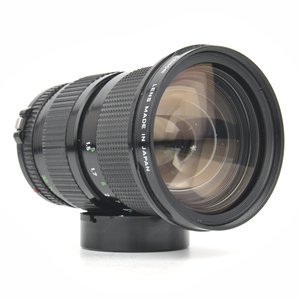
The convenience of partnering a A-1 with a zoom lens is appealing. Having the capability of using a range of focal lengths without the need to swap a lens is wonderful.
Take into consideration that these are vintage zoom lenses.
- Haze and or Fungus
- Large amount of dust in the lens
- Loose or tight zoom ring
- Loose or tight focus ring
- Oil on the aperture blades
- Decentered lens elements
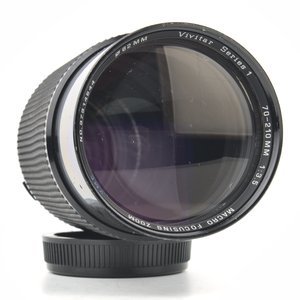
Additionally, you need to keep in mind the drawbacks the lenses have even when in excellent condition.
- Image quality will not be good when shot wide open.
- One or both ends of the focal range may suffer from a large amount of distortion.
- Zoom lenses are larger and generally heavier than primes.
Alternative Zoom Lenses
Regarding pricing, many older zoom camera lenses are going to be affordable.
- Canon FD 70-210mm f/4
- Canon FD 80-200mm f/4L
- Canon FD 28-85mm f/4
Macro Lens
Vivitar 90mm f/2.8 & Vivitar 55mm f/2.8
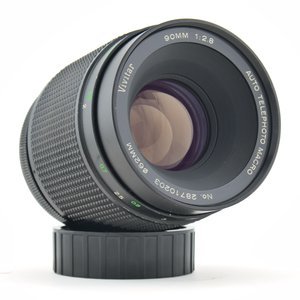
- My favorite vintage macro lens.
- Available in multiple lens mounts.
- Incredible value.
- Sharp corner-to-corner at f/8.
See current price and more information on:
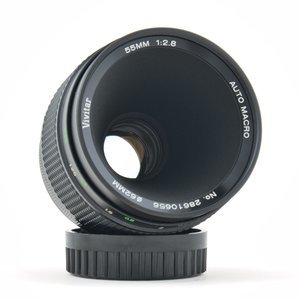
- My second favorite vintage macro lens.
- An excellent choice for close-up photography.
- It does not need an extension tube to reach 1:1 magnification.
See current price and more information on:
Komine produced the 2 recommened macro camera lenses in Japan. The lens was also released with several brand names. Rokunar, Elicar, Quantaray, Panagor, and Spiratone are names you can see on a copy of the lens.
There is a Vivitar 90mm f/2.8 Macro Lens Review and a Vivitar 55mm f/2.8 Macro Lens Review.
For taking pictures at lifesize magnification (1:1), the 90mm lens is without a doubt the superior pick due to the fact that it has a greater working distance.
The 55mm focal length lens is very good for table-top and close-up photography.
Alternative Macro Lenses
- Canon FD 50mm f/3.5
- Canon FD 100mm f/4
- Canon FD 200mm f/4
Used FD Camera Lens Prices
Prices change on a regular basis. During the past 3-4 years, involvement in film photography has been increasing. As a result, price ranges have gradually climbed.
To end up with the lowest price, geta lot of sites. Immediately purchase a great price the moment you find one simply because the best deals sell the quickest.
What Lens Mount Does the Canon A-1 Use?
The A-1 works with the Canon FD lens mount. Canon used the FD mount for film cameras manufactured from 1971 until 1992.
Here is a list of all the cameras that have a Canon FD mount.
The Canon FL lens mount was replaced by the FD mount, which was used between 1964-1971. FL mount lenses are compatible with the A-1, but you will be required to use stopped down metering.
Standard Lens Cap Size
The standard lens cap and filter ring thread diameter for Canon FD lenses is 55mm.
Employing a standardized filter thread size is useful due to the fact that you only need to own and bring 1 set of filters.
Several zoom and telephoto lenses have larger filter ring thread diameters since they have enormous front lens elements.
FD vs FL Lens Mount
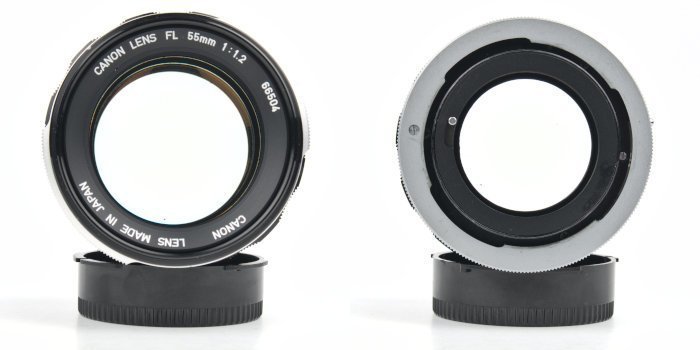
The Canon FL mount preceded the FD mount. You can make use of FL lenses on the FD mount, and FD mount lenses can be used on the FL lens mount.
What Canon FL lenses do not have the technology to automatically do stop-down metering. As a consequence FL mount lenses have to be stopped down with the depth-of-preview switch in order for the A-1’s light meter to show the proper value.
FD vs new FD Lenses
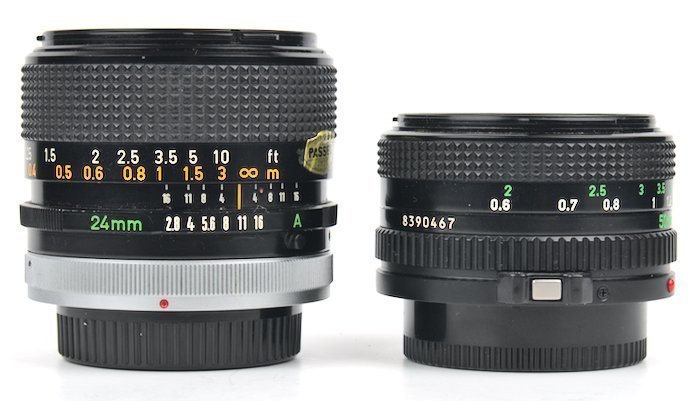
The entire new FD lens rotates to lock onto the camera. In contrast to original FD lenses have a breech-lock ring at the back of the lens that is required to be tightened in order to secure a lens to the camera.
New FD and FD lenses are interchangeable with one another. There will be no compatibility issues.
Occasionally you will spot new FD lenses referred to as FDn lenses.
The switch in the design of the breech-lock ring was on account of complaints. A small number of people endured lenses getting jammed on a FD camera.
If you have not mounted an FD mount lens to a camera body, don’t be anxious. Simply take it slow and don’t force anything.
Telling FD and FDn Lenses Apart
It is simple to tell new FD and FD lenses apart. New FD lenses have a silver button located on the outside of the lens, where the lens mounts to the camera.
The earlier FD lenses have a ring that is required to be rotated after the lens is put on the camera to lock it into place.
